The Neon Pothos is the party girl of the Pothos world.
A living, breathing glow stick; she’s bright, fun, carefree, and will liven up any room in an instant.
This captivating plant (obviously) earned its name due to its bright lime leaves and also goes by the name Neon Devils Ivy – the devilish nickname hinting at its practically indestructible nature and rapid growth.
Thankfully, these qualities also make Epipremnum aureum ‘ Neon’ extremely easy to care for and a great option for plant parents of all abilities.
With a little love and know-how, this zingy beauty is both an indoor plant that won’t let you down and a terrarium plant that will add a vibrant splash of color to any piece.
Read on to find out how to get your Neon Pothos shining bright!
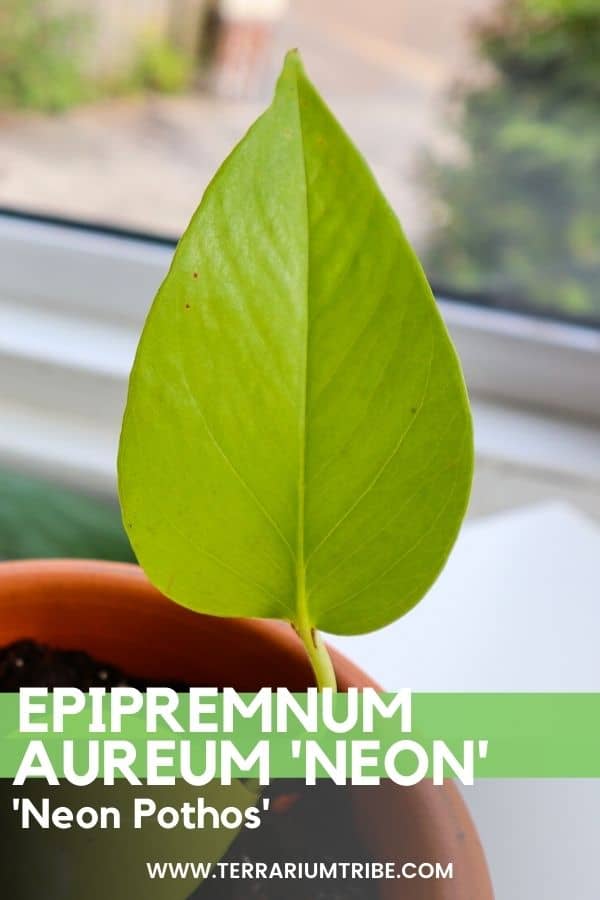
What is the Neon Pothos? (Besides being Awesome)
Originating from the South Pacific Archipelagos, this beautiful plant with stunning ovate green leaves is about as tropical and vivid as you can get.
I’ve yet to see another plant that can match its acid-green vibrancy – it looks almost too striking to be natural.
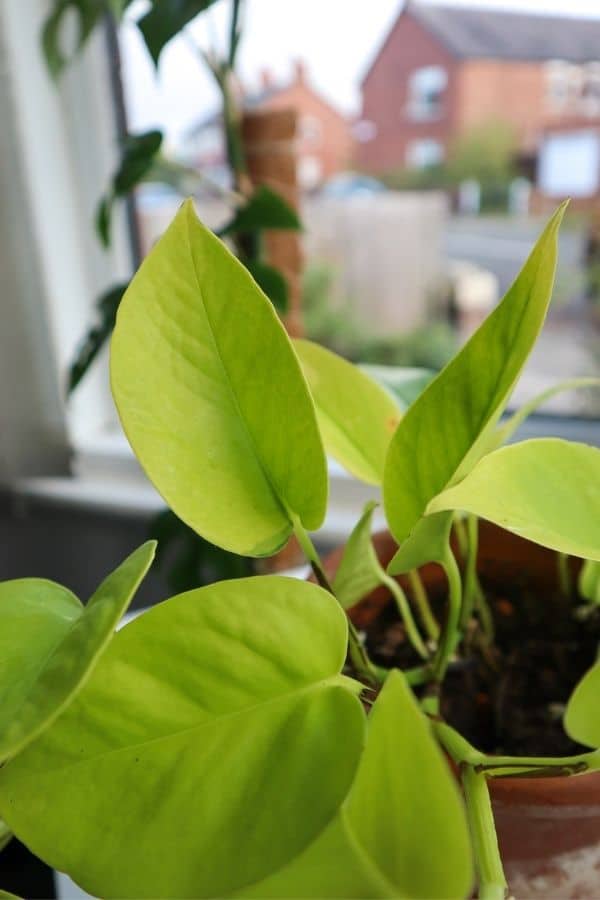
In the wild, Epipremnum aureum ‘Neon’ is an aggressive vining species, and would be seen climbing up trees in the rainforest. There have been plants of this genus recorded reaching crazy heights of up to 70ft!
It’s such an aggressive grower that in some parts of the world, it’s actually considered an invasive and threatening species (I think there’s even a ban on growing it outdoors in some states).
But, when it comes to my home, I’m more than happy for the gorgeous Neon Pothos to take over and turn my place into a luscious indoor jungle.
Though in a terrarium, you’ll need to put this plant in a large terrarium with lots of space, or be prepared to trim it back regularly.
Where to Find the Neon Pothos for Sale
See the links below to purchase from reputable terrarium plant shops and marketplaces (may include affiliate links).
Neon Pothos Care & Growth
At a Glance
| Plant Type | Vine, foliage |
| Lighting | Bright indirect light |
| Temperature | 60-90°F (16-32°C) |
| Watering | Moderate, even moisture |
| Humidity | Moderate to high humidity (60-95%) |
| Growth | 10ft+ vine |
Lighting
The Neon Pothos will do best placed in a bright spot, just out of direct sun.
In its natural environment, it’s an epiphytic vine that climbs up the native trees to snatch some sun so it can reasonably tolerate both lower light and brighter light.
I keep all of my Pothos plants a few feet away from a South-East facing window, and they thrive there. They get some direct morning sun, then bright indirect light for the rest of the day, and I’ve never had any issues with scorching leaves.
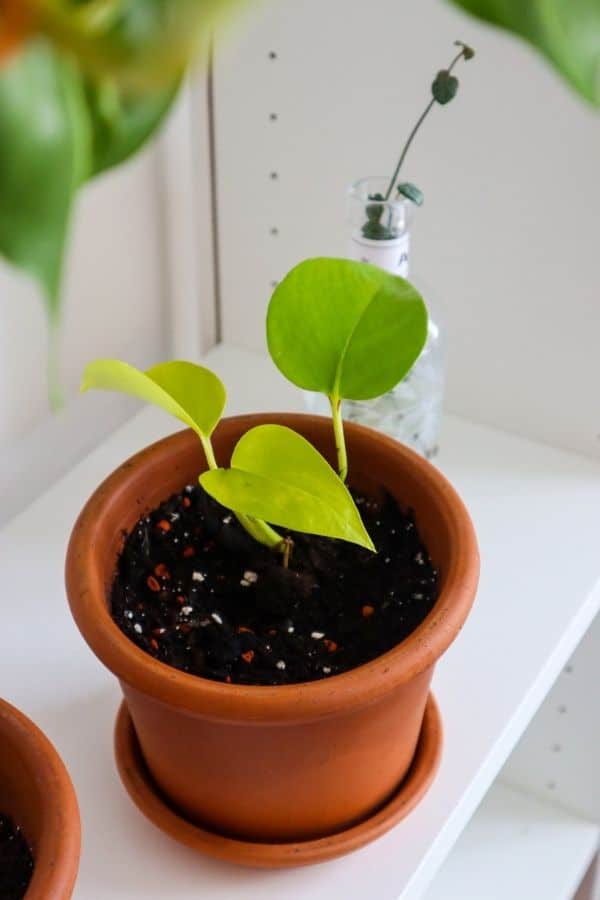
Just bear in mind that I live in the North East of England, which unfortunately lacks an abundance of sunny days… so you might need to move yours a little further away if you live in a sunnier place.
As terrarium plants are almost universally suited to bright indirect light, this bright Pothos is a well-suited addition. And it can absolutely adapt to lower light conditions!
The leaves will likely darken a little, losing some of the electrifying vibrancy, and the growth rate will be slowed, but it will still grow if you have limited lighting.
Watering
Luckily for us, this plant is fairly drought-tolerant.
The first thing I do when a friend tells me that they’re not good at keeping plants alive is hand them a Pothos cutting with an “Oh, just you try and destroy it” attitude.
They love regular moisture but don’t like sitting in excess water – so I like to give mine a nice break between waterings.
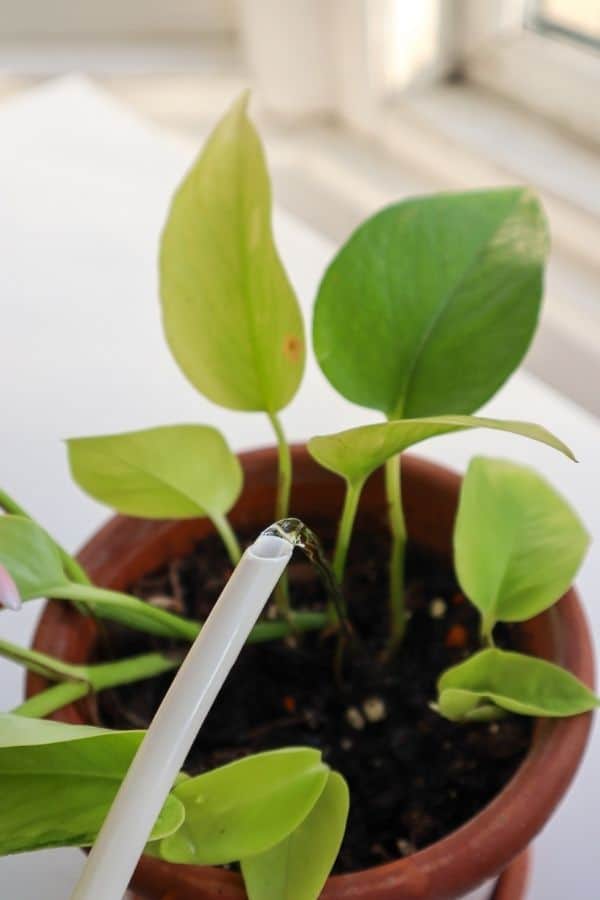
Like Fittonia, the Neon Pothos will show you if it’s feeling neglected by playing the drama queen, getting limp, and having a little faint, but I’ve never seen that in my own plants. You must need to REALLY let it go thirsty to see that.
To avoid root rot, let the soil dry out reasonably between waterings, and, of course, make sure your pot has a drainage hole. You can test the soil moisture with your finger.
Only water when it’s feeling a little dry to the touch, and give it a good drink when you do.
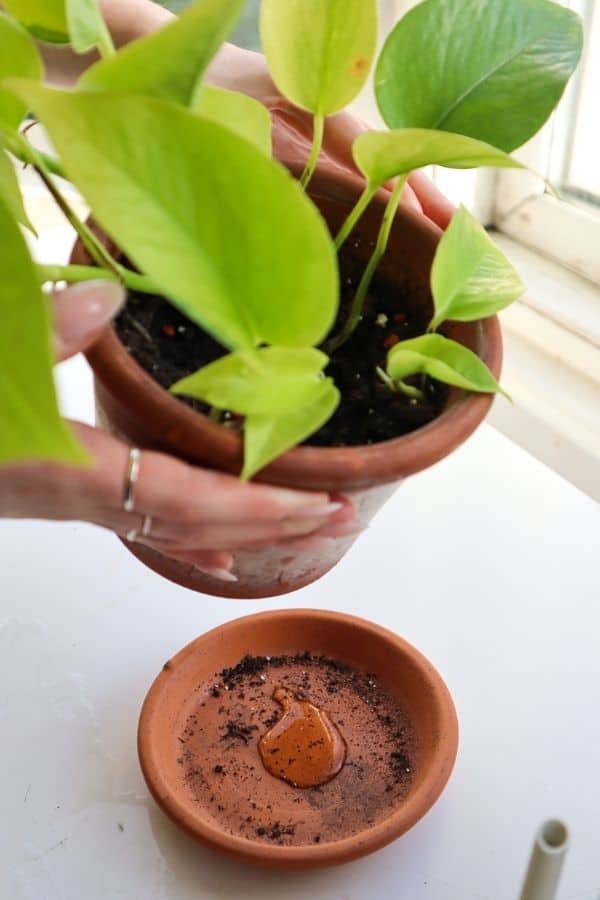
In a terrarium, you can stay on the safe side by adding a drainage layer and making sure there isn’t too much water in the system.
Substrate / Soil
As with every tropical plant, the Neon Pothos doesn’t like sitting in soggy soil – I can’t blame it, really!
So, I’m just going to push the whole “get a pot with a drainage hole” point again. If I had my way, I’d ban hole-less pots.
As it’s a partially epiphytic vine, you’ll want a substrate mix that has good water retention, root aeration, and drains well. Any good quality tropical mix should do the trick, and you can always add extra perlite or similar as necessary.
In a terrarium, it’s especially important to get the right substrate mix – as, unlike your pots, a drainage layer can’t drain indefinitely, and it’s much easier to overdo the watering.
Temperature & Humidity
Honestly, an Epipremnum aureum of any variety is about the hardiest plant you can get your mitts on. It’ll most likely take whatever you can give it and do its level best to please you.
It can grow anywhere between 60 and 90 degrees without complaint, but as it’s a tropical species with a preference for warm temperatures, it’ll really go the extra mile between 70 and 85.
This Pothos will really live up to the “Devil’s Ivy” term and won’t let lower humidity stop it, but they do LOVE a humid environment in the range of 60-90% if you can provide them with it!
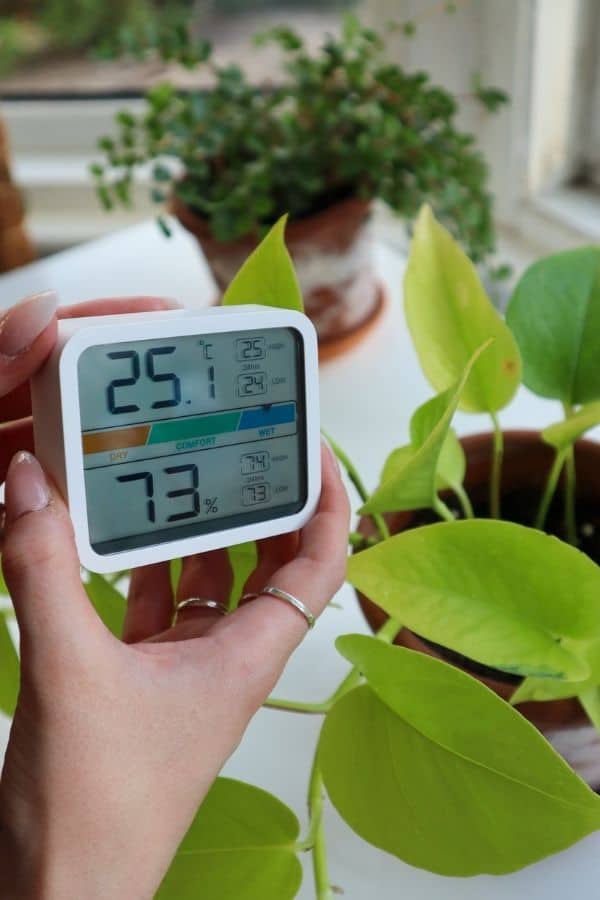
However, I’ve just had a Google, and some of the South Pacific Islands are upwards of 95%, so do with that information what you will. I imagine when it comes to humidity, this genus will adopt a “the more the merrier” stance.
And, of course, this means they absolutely adore being popped in a closed terrarium environment for maximum warmth and humidity.
Growth
This plant will grow fast, and it’ll bring you so much joy as it does so.
As a houseplant, it performs best when you give it something to climb, such as a moss pole or something to dangle from, like a hanging basket.
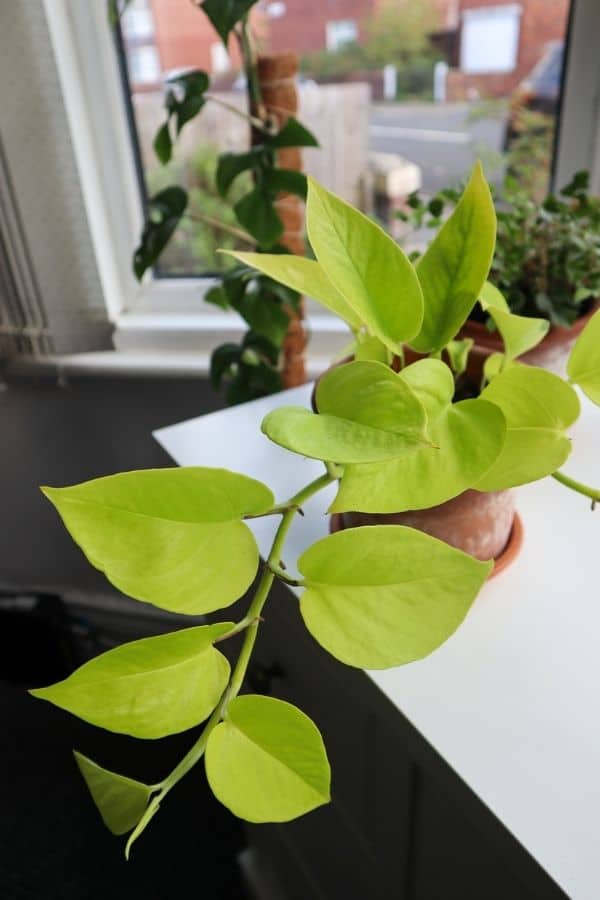
My Golden Pothos sits on top of my wardrobe and trails down. It’s almost reached the ground and currently measures around 6ft at 2 years old. So, it’s perfectly possible for an Epipremnum aureum to reach 6-8 ft+ in the home.
Don’t let that stop you if you want a neater plant, though – it responds very well to a trim and will result in a fuller plant!
As a tropical plant (and so suited to warm temperatures and a humid environment), it’s a great fit for a terrarium. But this comes with one main caveat.
Being a quick grower, it’ll need regular maintenance, making it a perfect choice for the involved terrarium plant parent.
It can quickly outgrow the terrarium if left to its own devices for too long, so you’ll find yourself pruning it fairly frequently (though that just means more Neon Pothos cuttings to propagate, right?).
Epipremnum aureum can flower when it’s reached full maturity (in the wild), but it’s not particularly cute, and not possible to reach that level of maturity indoors.
Propagation
You’ll never meet a plant so easily propagated as an Epipremnum aureum. These guys readily multiply, and they’re very happy to do it.
Nothing fancy here, just a simple stem cutting method will work a treat.
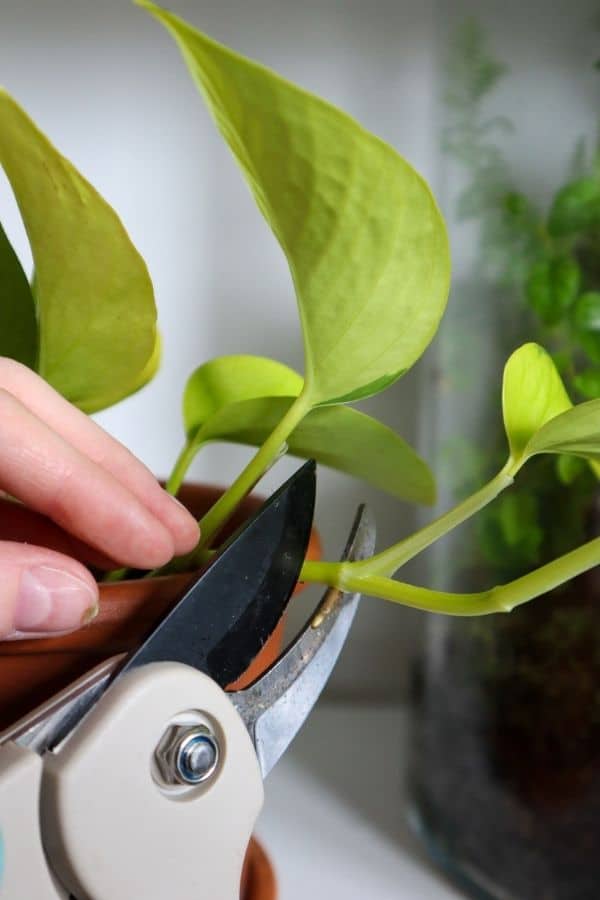
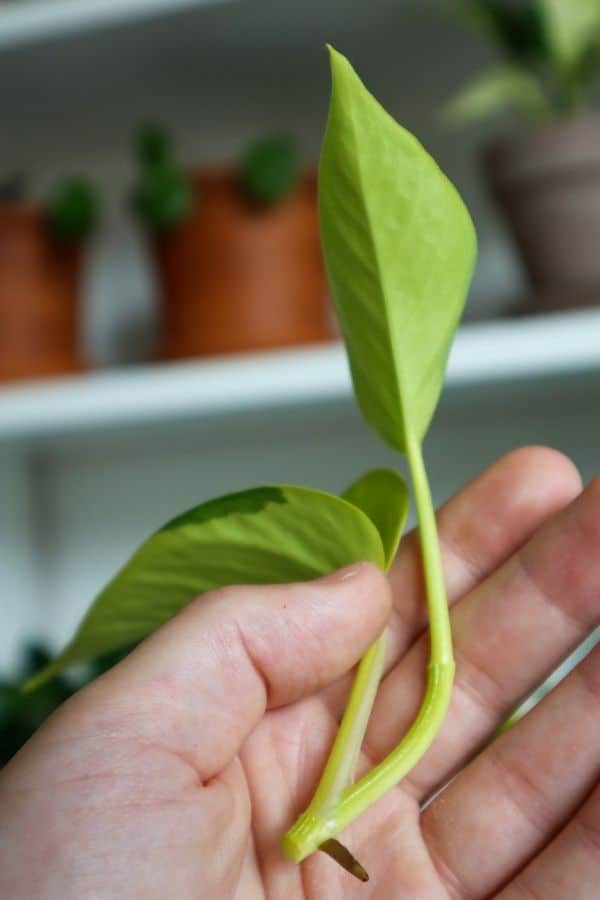
Snip underneath a leaf node with some sharp scissors, pop your leaf in water and you should see some roots developing in just a few days.
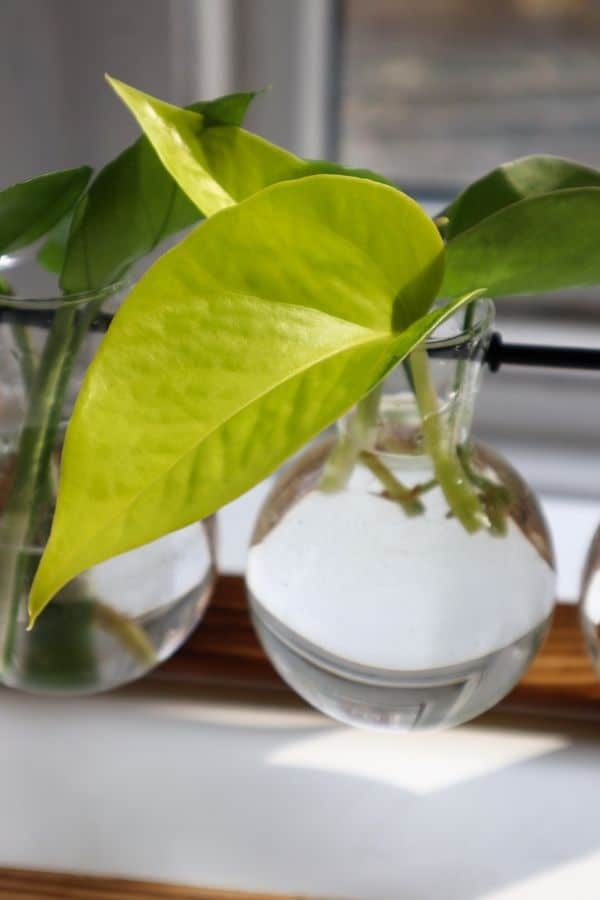
Give it a few weeks until the roots are nicely established, and then plant it up into a tropical potting mix – voilá.
You can plant your stem cuttings back into the mother plant if you’re wanting to make it bushier and bigger, or give it to a pal and spread the neon love if you’re feeling generous.
Rinse and repeat with every leaf node until you have thousands and become the supreme Pothos ruler.
Varieties & Similar Plants
There are plenty of gorgeous Pothos plants to collect if you’re up for the challenge (I can’t seem to stop hitting add to cart on every new cutting I come across these days).
From the beautiful speckled Marble Queen and Pearls and Jade, to the N-Joy (which visually lives up to the ivy namesake in my opinion), and the Manjula, Jessenia and Jade Pothos – there are SO many varieties to liven up your home or terrarium project.
And, of course, what plant person doesn’t own a Golden Pothos? It’s literally a rite of passage.
There’s also the Satin Pothos, which is a real showstopper – though it’s technically a Scindapsus, not an Epipremnum.
The Neon Pothos could easily be mistaken for a Philodendron Lemon Lime, which shares the gorgeous neon color but sports more Philodendron-shaped leaves (as you might expect).
Even within the Neon Pothos itself, there are some variegated forms, both in white and a darker green.
Check out our Epic Guide to Pothos Varieties for more inspiration!
Frequently Asked Questions
Regrettably, yes, like all plants that come from the Araceae family, all Pothos are toxic to not only our feline and canine friends, but people too. So, if you have a fur baby (or a baby of the human variety), you might want to give the Pothos a miss. Or our favorite solution by far is to solve this problem by putting it in a closed terrarium away from little teeth. Your furry friend or little one stays safe, and your plant gets more humidity. Win-win.
Yellow leaves are a sign of pretty much anything that could be wrong with a plant. Unhelpful, I know… When it comes to underwatering, you’d likely see your plant get limp and floppy before you’d see any yellowing. So, unless you’re seriously neglecting your plant, it’s most likely to be overwatering or incorrect lighting, in my opinion. Yellow leaves (leading to brown spots) can be a sign of root rot – so the first thing to check is to make sure that your plant isn’t sat in wet soil. If that’s not it, check that you’re meeting the right light requirements. If this plant isn’t getting enough light, it can go all yellow on you.
Brown leaves or brown leaf tips are more likely to do with too much light or potentially not enough humidity. Think rainforest, not desert, with this plant – it loves warm temperatures but not harsh sun. If the light conditions are too intense, the leaves can scorch. Brown leaf tips could also be a sign of using too much liquid fertilizer. I only fertilize my Pothos once or twice a year, and that’s more than enough. You’ll find this plant doesn’t need much in the fertilizer department – if it’s happy, it will grow plenty by itself.
Your plant isn’t getting enough light and is trying its very best to compensate. Get it closer to a light source or install an artificial fluorescent light if that’s not possible.
Absolutely! It can temporarily improve humidity, keep leaves clean for photosynthesis, and encourage aerial root growth (which is great if you’re training your plant to climb a moss pole).
